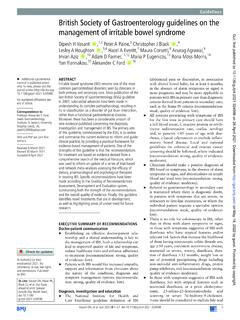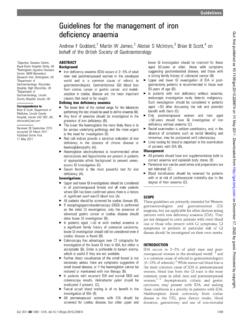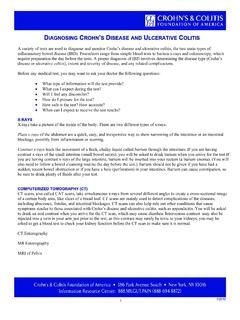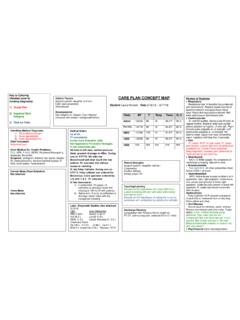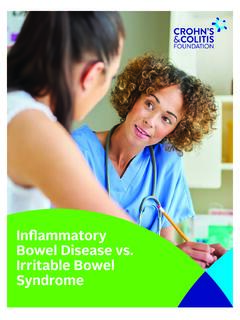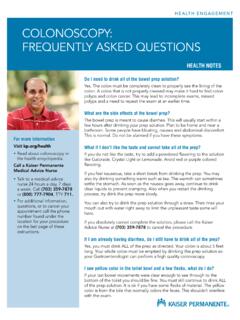Transcription of Guidelines Management of Helicobacter pylori infection the ...
1 Guidelines Management of Helicobacter pylori infection the Maastricht V/Florence Consensus Report Gut: first published as on 5 October 2016. Downloaded from on February 5, 2022 by guest. Protected by copyright. P Malfertheiner,1 F Megraud,2 C A O'Morain,3 J P Gisbert,4,5 E J Kuipers,6 A T Axon,7. F Bazzoli,8 A Gasbarrini,9 J Atherton,10 D Y Graham,11 R Hunt,12,13 P Moayyedi,14. T Rokkas,15 M Rugge,16 M Selgrad,17 S Suerbaum,18 K Sugano,19 E M El-Omar,20. on behalf of the European Helicobacter and Microbiota Study Group and Consensus panel Additional material is ABSTRACT complexity of gastric functions in health and published online only. To view Important progress has been made in the Management disease has recently addressed this please visit the journal online ( of Helicobacter pylori infection and in this fth edition of The aim of this report is to serve as a gutjnl-2016-312288). the Maastricht Consensus Report, key aspects related to state-of-the-art guide for the Management of the clinical role of H.
2 pylori were re-evaluated in 2015. H. pylori infection and related clinical manifesta- For numbered af liations see end of article. In the Maastricht V/Florence Consensus Conference, 43 tions and also as an inspiration for new clinical experts from 24 countries examined new data related to research in the area. Correspondence to H. pylori in ve subdivided workshops: (1) Indications/ In the Maastricht V/Florence Consensus Report Professor P Malfertheiner, Associations, (2) Diagnosis, (3) Treatment, (4) 43 experts from 24 countries convened for 2 days University of Magdeburg, Department of Prevention/Public Health, (5) H. pylori and the Gastric for a face-to-face meeting after having been actively Gastroenterology, Hepatology Microbiota. The results of the individual workshops were involved in a previously started Delphi process as and Infectious Diseases, presented to a nal consensus voting that included all described below. Leipziger Str. 44, Magdeburg participants.
3 Recommendations are provided on the basis The working groups were set up according to the 39120, Germany; peter. of the best available evidence and relevance to the following topics: Management of H. pylori infection in the various clinical Working group 1: Indications/Associations Received 19 May 2016 scenarios. Working group 2: Diagnosis Accepted 9 August 2016 Working group 3: Treatment Published Online First Working group 4: Prevention/Public Health 5 October 2016. Working group 5: H. pylori and the Gastric INTRODUCTION Microbiota Nearly 4 years after publication of the Maastricht IV/Florence Consensus Report1 the content has METHODOLOGY. been updated by maintaining the traditional inter- The evidence-based Delphi process developed con- val considered appropriate for capturing progress sensus statements following proposals by desig- in the eld of Helicobacter pylori related clinical nated coordinators. The process allowed individual issues and adapting the Management to current feedback and changes of views during the process demands.
4 Regulated by the coordinators and the consensus Among the challenges, the increasing H. pylori chair. resistance to previously ef cacious antibiotic regi- The principal steps in the process were: (a) selec- mens is of great concern and requires modi cation tion of the consensus group; (b) identi cation of of therapeutic strategies. Furthermore, new studies areas of clinical importance; (c) systematic literature have been conducted to demonstrate the feasibility reviews to identify evidence to support each state- and ef cacy of primary and secondary gastric ment, draft statements and discussions supported cancer prevention. A recent important evolution by the evidence speci c to each statement. has taken place by the publication of the Kyoto Two rounds of voting were conducted. consensus Key outcomes of this consensus The delegation was asked to choose one of the fol- report include the designation of H. pylori gastritis lowing ratings for each statement: as an infectious disease with the recommendation agree strongly of treatment of all H.
5 pylori infected subjects. This agree with reservation represents a paradigm shift, as the indication for undecided treatment is no longer reserved for patients with disagree or clinical manifestations of the infection . In the same disagree strongly. consensus, H. pylori gastritis with dyspeptic symp- When no strong agreement was reached, the toms was designated as a speci c entity outside the statement was rephrased and the vote was repeated. umbrella' de nition of functional dyspepsia. Both Evidence-based discussions with key references these aspects have been carefully re-examined. The were provided for each statement on which partici- role of H. pylori infection has also been assessed pants voted. Consensus had to be reached by 80%. with the perspective of potential interactions with of respondents who (a) strongly agreed or (b). other microbiota in the upper and lower digestive agreed with reservation. To cite: Malfertheiner P, system, as the gut microbiome has emerged as an The level of evidence and strength of the recom- Megraud F, O'Morain CA, essential player in human health and disease.
6 A mendations were completed only after the individ- et al. Gut 2017;66:6 30. comprehensive and updated overview on the ual working group meetings. Based on the type of 6 Malfertheiner P, et al. Gut 2017;66:6 30. Guidelines studies, evidence levels and grade of recommendation were test as well as H. pylori -related disease are both low. a lower either based on the system used in the previous consensus prevalence of H. pylori in the population increases the chance reports (see online supplementary appendix)1 or, if statements that a positive H. pylori serology test is false. This implies that Gut: first published as on 5 October 2016. Downloaded from on February 5, 2022 by guest. Protected by copyright. were suitable for grade assessment, based on so called PICO the positive predictive value of the test declines with decreasing questions (PICO: population, intervention, comparator, H. pylori prevalence. In such a population, a chance of outcome) they have been graded non-H.
7 pylori -related pathology is higher than the risk of The Face to Face meeting was held in 8 9 October 2015 and H. pylori -related disease. The use of an endoscope and treat reviewed the statements in individual working groups rst approach in regions of low H. pylori prevalence may be consid- which were then presented to all delegates for nal voting. ered as it may offer additional bene t by ruling out signi cant Statements that have passed the 80% consensus threshold are oesophageal pathology. reported in here. When alarm symptoms are present weight loss, dysphagia, overt gastrointestinal (GI) bleeding, abdominal mass or iron de ciency anemia an OGD is When the risk of WORKING GROUP 1: INDICATIONS/ASSOCIATIONS gastric cancer is high, the test-and-treat' strategy is not recom- mended, and OGD is preferred, especially in older adults in Statement 1: H. pylori gastritis is an infectious disease irrespective of symptoms whom non-invasive tests are less The threshold and complications.
8 Varies between regions depending on the age of the subject with Level of evidence: 1B Grade of recommendation: A gastric cancer. H. pylori is a human pathogen that is transmitted from human to human, and causes chronic active gastritis in all colo- Statement 3: An endoscopy -based strategy should be considered in patients with nised subjects. This can lead to peptic ulcer disease, atrophic dyspeptic symptoms, particularly in low prevalence H. pylori populations. gastritis, gastric adenocarcinoma, and MALT (mucosa-associated Level of evidence: very low Grade of recommendation: weak lymphoid tissue) lymphoma. H. pylori eradication cures gastritis and can alter the progression to long-term complications, or endoscopy should include visualisation of the whole upper recurrence of disease. For these reasons, H. pylori is considered GI tract that is, oesophagus, cardia, fundus in retro exion, an infectious disease irrespective of an individual's symptoms corpus, antrum, duodenal bulb, and descending duodenum in and stage of order to detect any pathology and to biopsy any visible lesion.
9 Biopsies according to standardised protocols need to be taken. If endoscopy is performed it should be quality assured, and in Statement 2: A test-and-treat strategy is appropriate for uninvestigated dyspepsia. countries with low H. pylori prevalence, it rules out signi cant This approach is subject to regional H. pylori prevalence and cost-benefit oesophageal pathologies. considerations. It is not applicable to patients with alarm symptoms or older patients. Level of evidence: high Grade of recommendation: strong Statement 4: H. pylori gastritis may increase or decrease acid secretion. Treatment may reverse or partially reverse these effects. In young patients with uninvestigated dyspepsia the Level of evidence: high Grade of recommendation: high test-and-treat' strategy with non-invasive tests is preferred rather than prescribing proton pump inhibitor (PPI) or direct People with non-atrophic antral-predominant gastritis have oesophago-gastro-duodenoscopy (OGD), avoiding cost, incon- high stimulated acid production due to decreased somatostatin in venience and 6.
10 The antrum, and increased gastrin levels compared with non- The rationale for Guidelines recommending a test-and-treat'. infected controls. Clinically, duodenal ulcer and non-ulcer dys- over an endoscope-and-treat' policy is based on the outcome of pepsia are common in this 17 In contrast, people with ve randomised controlled trials (RCTs).7 10 These ve studies atrophic gastritis (involving both antrum and corpus mucosa). were included in a meta-analysis6 and four were included in a have impaired acid production. This phenotype is associated with Cochrane There was a small but signi cant bene t for gastric proximal ulcers, more advanced precancerous lesions, and the endoscope-and-treat' strategy in terms of improvement of with an increased risk for gastric 19 In both of these pat- symptoms and patient But this was negated by a terns of gastritis, treatment of H. pylori resolves the gastritis and cost saving of US$389 per patient in the test-and-treat arm.


